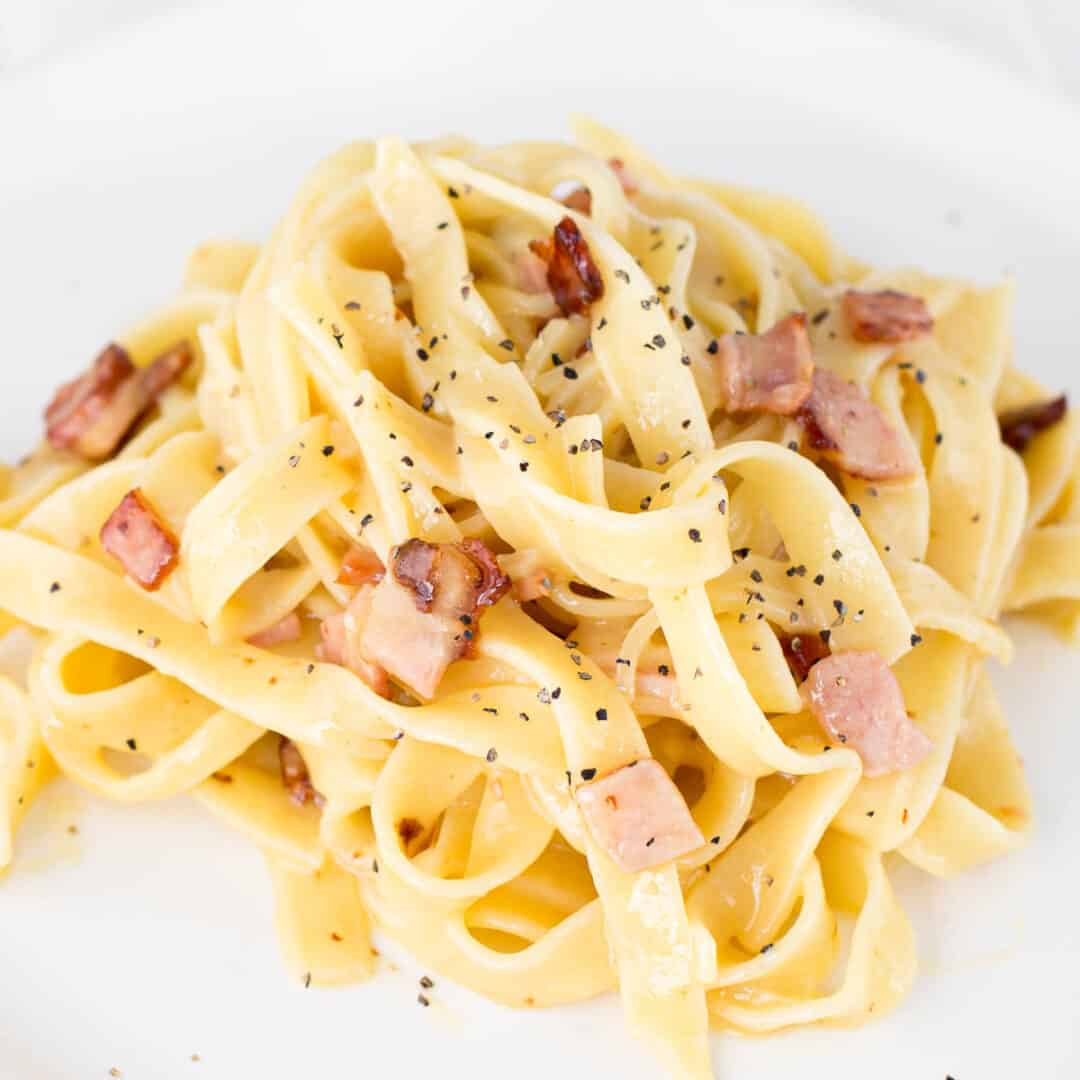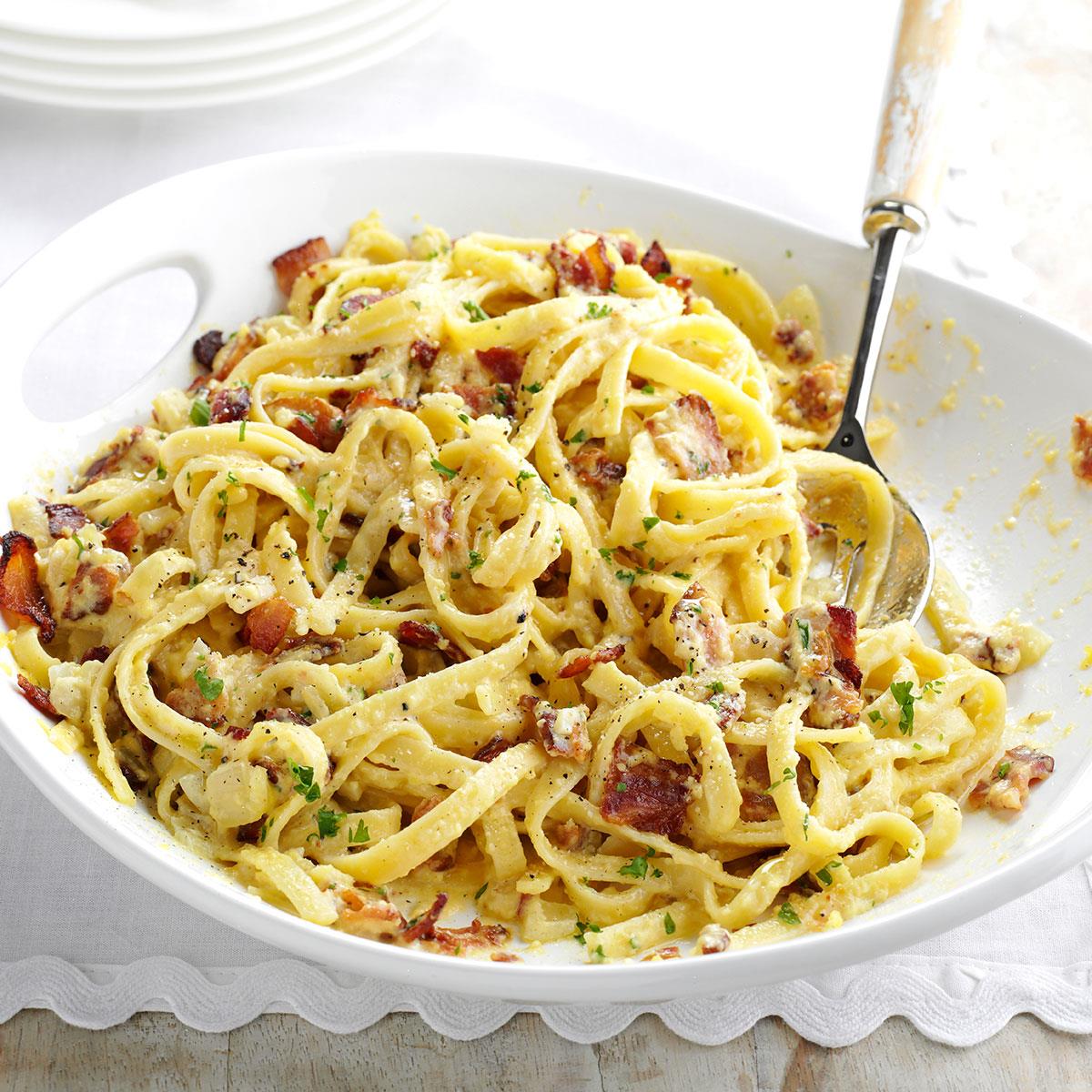Embark on a culinary journey as we delve into the world of carbonara, a classic Italian pasta dish renowned for its simplicity and richness. While traditional carbonara relies on eggs and cheese to create a luscious sauce, our focus today is on an innovative twist that incorporates milk, resulting in a velvety and creamy variation that is sure to tantalize your taste buds.
Carbonara, originating from the Lazio region of Italy, has captured the hearts of food enthusiasts worldwide with its harmonious blend of flavors and textures. The addition of milk to this classic recipe adds a delightful layer of creaminess without compromising the integrity of the dish.
Join us as we explore the secrets behind this delectable creation, guiding you through the steps of preparing an easy carbonara recipe with milk.
Introduction to Carbonara

Carbonara is a classic Italian pasta dish that has gained immense popularity worldwide. It originated in the Lazio region of Italy, specifically in the city of Rome. The traditional recipe consists of spaghetti, eggs, pecorino Romano cheese, guanciale (cured pork cheek), and black pepper.
The dish is known for its creamy and rich sauce, made by combining the eggs and cheese, and the smoky flavor of the guanciale.
In recent times, variations of carbonara have emerged, including the use of milk as an alternative to eggs. This adaptation offers a lighter and creamier texture to the sauce while still maintaining the essence of the classic dish. The milk-based carbonara has become a popular choice among those who prefer a milder flavor or have dietary restrictions related to eggs.
Role of Milk in Carbonara
The use of milk in carbonara serves several purposes:
- Creamy Texture: Milk adds a smooth and creamy texture to the sauce, making it less rich and heavy compared to the traditional egg-based version.
- Milder Flavor: Milk imparts a milder and more subtle flavor to the sauce, making it more palatable for those who find the traditional carbonara too strong or overpowering.
- Dietary Restrictions: For individuals with egg allergies or dietary restrictions, milk provides a suitable substitute that allows them to enjoy the flavors of carbonara without compromising their dietary needs.
Step-by-Step Recipe
Creating an easy carbonara recipe with milk involves a few simple steps that yield a creamy and flavorful pasta dish. Let’s dive into the detailed guide, ensuring clarity and ease of understanding.
Ingredients Preparation
Before beginning the cooking process, it’s essential to prepare the ingredients. Gather and measure the following:
- 1 pound of spaghetti or linguine pasta
- 1/2 cup of grated Parmesan cheese
- 1/4 cup of grated Pecorino Romano cheese
- 1/2 cup of whole milk
- 3 large eggs
- 1/4 cup of chopped fresh parsley
- 1/4 cup of chopped fresh basil
- Salt and pepper to taste
Cooking the Pasta
1. In a large pot, bring salted water to a boil. Once boiling, add the pasta and cook according to the package instructions. Stir occasionally to prevent sticking.
2. While the pasta cooks, prepare the carbonara sauce. In a large bowl, whisk together the eggs, milk, Parmesan cheese, Pecorino Romano cheese, salt, and pepper until well combined.
Making the Carbonara Sauce
1. Once the pasta is cooked al dente, drain it, reserving 1/2 cup of the pasta cooking water.
2. Immediately add the drained pasta to the bowl with the carbonara sauce and toss well to coat. Add some of the reserved pasta cooking water if the sauce seems too thick.
Final Touches
1. Transfer the pasta to a serving dish and garnish with the chopped parsley and basil.
2. Serve immediately, while the pasta is hot and the sauce is creamy.
Variations and Customization
The easy carbonara recipe with milk offers a versatile base for exploration and customization. Feel free to experiment with different ingredients and techniques to create a dish that suits your taste and dietary needs.
Cheese Variations
- Parmesan: The classic choice for carbonara, Parmesan adds a salty, nutty flavor to the dish.
- Pecorino Romano: A sheep’s milk cheese that is sharper and more pungent than Parmesan, Pecorino Romano adds a distinct flavor to the sauce.
- Asiago: A cow’s milk cheese with a mild, nutty flavor, Asiago is a good option for those who prefer a milder cheese.
- Gorgonzola: A blue cheese with a strong, pungent flavor, Gorgonzola adds a unique twist to the classic carbonara recipe.
Vegetable Additions
- Asparagus: Sautéed asparagus adds a crisp, green touch to the dish.
- Peas: Frozen or fresh peas add a pop of color and sweetness.
- Broccoli: Chopped broccoli florets add a healthy dose of vegetables to the carbonara.
- Spinach: Wilted spinach adds a touch of bitterness and nutrients.
Protein Variations
- Bacon: A classic addition to carbonara, bacon adds a smoky, salty flavor.
- Pancetta: An Italian cured meat similar to bacon, pancetta has a slightly milder flavor.
- Prosciutto: Thinly sliced prosciutto adds a delicate, salty flavor to the dish.
- Chicken: Cooked chicken is a good option for those who prefer a leaner protein.
Customizing for Dietary Restrictions
The easy carbonara recipe with milk can be easily adapted to suit various dietary restrictions.
- Gluten-Free: Use gluten-free pasta or rice noodles instead of traditional wheat pasta.
- Vegetarian: Omit the bacon or pancetta and use vegetable broth instead of chicken broth.
- Vegan: Use a plant-based milk, such as almond or soy milk, instead of cow’s milk. Additionally, use a vegan cheese alternative, such as nutritional yeast or cashew cheese.
Impact of Ingredient Substitutions
Substituting ingredients in the easy carbonara recipe with milk can impact the final dish in various ways.
- Milk: Using a different type of milk, such as almond or soy milk, will affect the flavor and texture of the sauce.
- Cheese: Using a different type of cheese will change the flavor and texture of the sauce. For example, using a sharp cheddar cheese will result in a more pronounced flavor, while a mild cheese like mozzarella will produce a milder sauce.
- Protein: Using a different type of protein, such as chicken or tofu, will change the flavor and texture of the dish.
Serving Suggestions

Elevate your carbonara experience with thoughtful presentation and complementary accompaniments.
Serve the carbonara piping hot, allowing the creamy sauce to coat each strand of pasta perfectly. Consider garnishing the dish with freshly grated Parmesan cheese, a sprinkle of black pepper, and a drizzle of olive oil to enhance its flavors and visual appeal.
Side Dishes
- Green Salad: Pair the rich carbonara with a refreshing green salad. A simple mix of romaine lettuce, cherry tomatoes, cucumbers, and a light vinaigrette dressing can provide a crisp and healthy contrast to the creamy pasta.
- Garlic Bread: Enjoy the ultimate comfort food combination by serving carbonara with garlic bread. Toast baguette slices, brush them with olive oil, and sprinkle with garlic powder. Bake until golden brown, creating a perfect vessel for scooping up the creamy sauce.
- Roasted Vegetables: Add a colorful and nutritious element to your meal with roasted vegetables. Toss broccoli, zucchini, bell peppers, and cherry tomatoes with olive oil, salt, and pepper. Roast until tender-crisp, and serve alongside the carbonara.
Beverages
- White Wine: Enhance the flavors of carbonara with a glass of crisp white wine. Choose a light-bodied wine like Pinot Grigio or Sauvignon Blanc to complement the richness of the dish.
- Sparkling Water: For a refreshing non-alcoholic option, serve carbonara with sparkling water. Its effervescence can cleanse the palate and provide a light contrast to the creamy sauce.
- Fruit Juice: If you prefer a fruity accompaniment, opt for fresh-squeezed orange juice or apple juice. Their natural sweetness can balance the savory flavors of the carbonara.
Presentation
- Individual Portions: Serve carbonara in individual bowls or plates to create a sophisticated presentation. Arrange the pasta neatly, drizzle with olive oil, and garnish with Parmesan cheese, black pepper, and a sprig of fresh parsley.
- Family-Style Platter: For a communal dining experience, present the carbonara on a large platter. Arrange the pasta in the center, surrounded by roasted vegetables, garlic bread, and a selection of garnishes. Allow your guests to customize their plates with their favorite toppings.
Troubleshooting and Tips
The easy carbonara recipe with milk is generally straightforward, but certain challenges may arise during preparation. Understanding common issues and implementing effective solutions can ensure a successful cooking experience.
One potential challenge is the formation of scrambled eggs. To prevent this, it’s crucial to temper the eggs by slowly adding the hot pasta water to the egg mixture, continuously stirring to evenly distribute the heat. Additionally, avoid overcooking the pasta, as this can make it more susceptible to breaking apart during the mixing process.
Avoiding a Runny Sauce
If the sauce appears too runny, there are a few possible causes. Firstly, ensure that the pasta is cooked al dente, as overcooked pasta will release more starch, resulting in a thinner sauce. Secondly, use the correct amount of milk; too much milk can dilute the sauce, making it less creamy and flavorful.
Finally, allow the sauce to thicken naturally as it cools slightly before serving. If necessary, you can add a small amount of grated Parmesan cheese to further thicken the sauce.
Tips for a Perfect Carbonara
- Use high-quality ingredients, especially the cheese and eggs. Freshly grated Parmesan and Pecorino Romano cheeses provide the best flavor and texture.
- Cook the pasta in plenty of salted water to ensure it’s evenly cooked and flavorful.
- Reserve some pasta cooking water before draining to use in the sauce. This starchy water helps create a creamy and emulsified sauce.
- Don’t overcrowd the pan when cooking the pancetta or bacon. This will prevent it from crisping properly and releasing its flavor.
- When adding the egg mixture to the pasta, stir vigorously to prevent the eggs from scrambling.
- Serve the carbonara immediately, as it’s best enjoyed when freshly made.
Last Point
As we conclude our culinary adventure, we hope you have gained a newfound appreciation for the versatility of carbonara. The introduction of milk has opened up a world of possibilities, allowing you to experiment with different ingredients and flavors to create a dish that perfectly suits your palate.
Whether you prefer a classic carbonara or are intrigued by the creamy embrace of milk, the easy carbonara recipe we shared today is sure to become a staple in your kitchen. So, gather your ingredients, put on your apron, and embark on a culinary journey that will leave you craving more.
FAQ Summary
What are the key differences between traditional carbonara and carbonara with milk?
Traditional carbonara relies on eggs and cheese to create a creamy sauce, while carbonara with milk incorporates milk instead of eggs, resulting in a lighter and creamier texture.
Can I use any type of milk in this recipe?
While whole milk is the preferred choice for its rich flavor and texture, you can use low-fat or skim milk if you prefer a lighter version.
What are some variations of this recipe that I can try?
You can add sautéed vegetables like mushrooms, zucchini, or asparagus to your carbonara for a more colorful and flavorful dish. You can also experiment with different types of cheese, such as Parmesan, Asiago, or Pecorino Romano.
